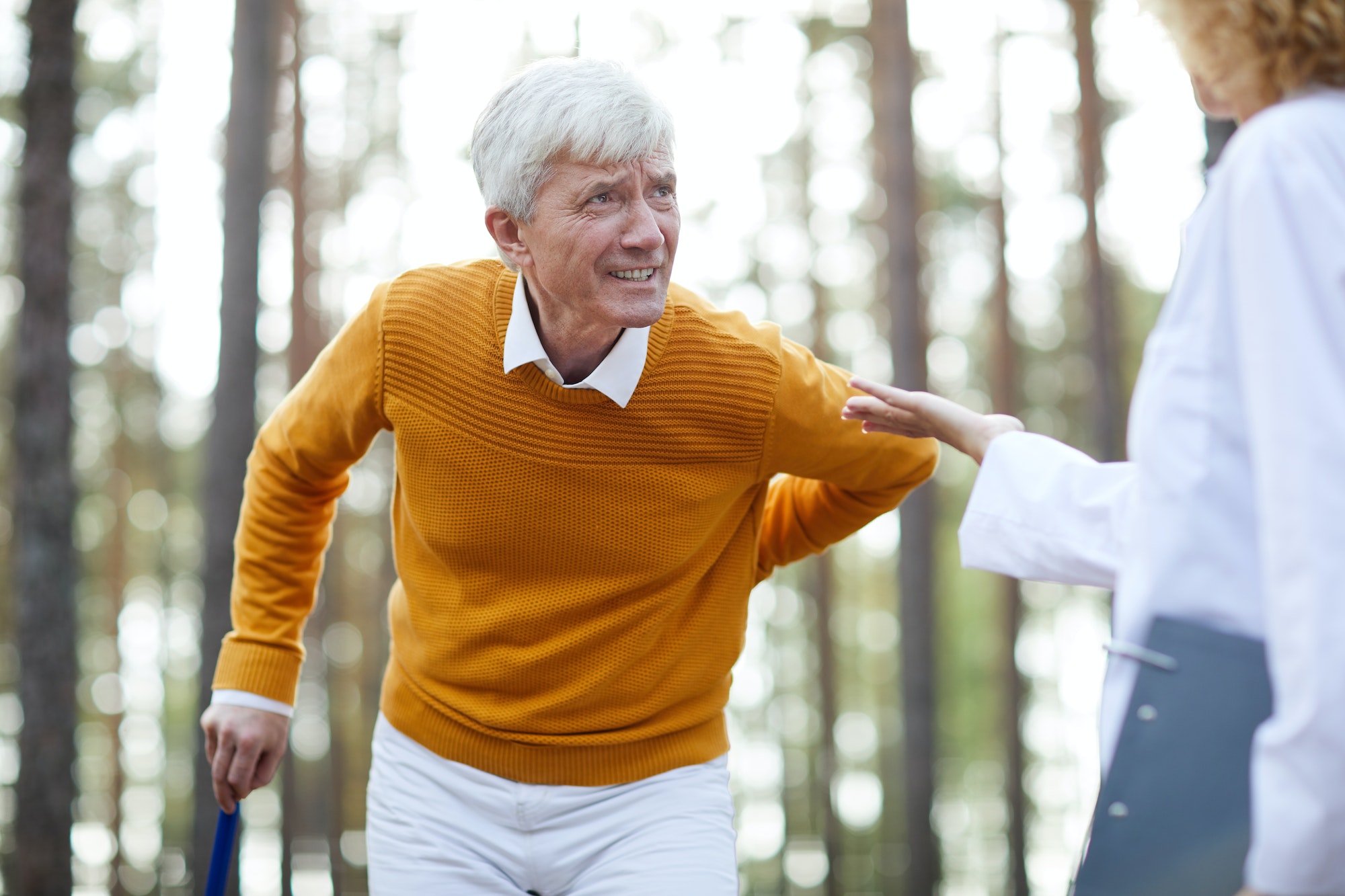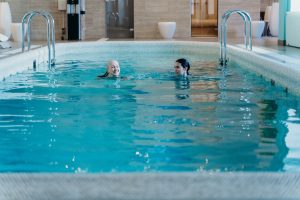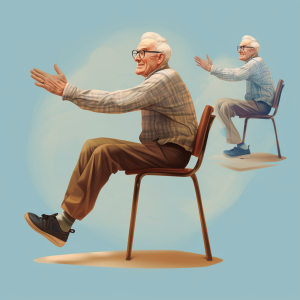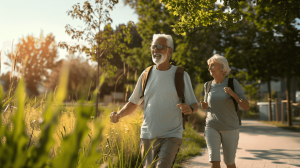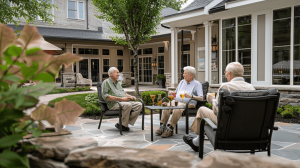As we age, the significance of back strengthening exercises for seniors becomes increasingly evident. Our spine, akin to a tree’s trunk, plays a pivotal role in our overall health and mobility. With the wear and tear of time, our muscles may weaken, leading to a deteriorating posture and reduced mobility.
So, for seniors, what’s the roadmap to revitalizing this essential region of the body? Dive into this comprehensive guide on back strengthening exercises, tailored specifically for our beloved senior community.
Contents
- 1 Why Back Strength Matters For Seniors
- 2 Benefits of Improving Posture and Mobility
- 3 Safety First – Things to Remember
- 4 Top Back Strengthening Exercises
- 5 How Often Should Seniors Exercise?
- 6 Monitoring Progress and Staying Motivated
- 7 Tips to Avoid Injury
- 8 Seeking Expert Advice
- 9 Final Thoughts On Back Strengthening Exercises For Seniors
- 10 FAQs:
Why Back Strength Matters For Seniors
The back, often seen as just another part of our body, is in fact the backbone (quite literally) of our overall health and well-being. Think of it as the central highway connecting our body’s north to its south. For seniors, ensuring this ‘highway’ remains robust is imperative. Here’s why:
- Foundation of Balance: The back plays a crucial role in maintaining balance. For seniors, a strong back can mean the difference between stability and frequent falls. Like the foundation of a building, if the back is strong, the rest of the structure remains stable.
- Pain Reduction: Age often brings the unwelcome gift of chronic aches, especially in the back area. Back strengthening exercises for seniors can be the antidote. By maintaining a sturdy back, seniors can mitigate or even eliminate persistent discomfort, ensuring a pain-free daily life.
- Enhanced Mobility: The back supports a range of movements, from bending to pick up a grandchild to turning to greet a friend. A reinforced back ensures that seniors can continue enjoying these everyday activities without restriction.
- Improved Posture: Age might bring wisdom, but it can also bring a stooped posture. A strong back counteracts this, allowing seniors to stand tall and proud, exuding confidence.
- Protection Against Injuries: A robust back acts as a shield against potential injuries. When the back muscles are conditioned, they absorb stress better, reducing the risk of strains, sprains, and other injuries.
- Increased Independence: For many seniors, independence is a treasured aspect of life. A fit and functional back ensures they can manage daily tasks with ease, from carrying shopping bags to gardening, without relying on others.
- Boosted Mental Well-being: Physical health and mental well-being are intertwined. When seniors feel strong and pain-free, it positively influences their mental health, leading to an optimistic outlook and a zest for life.
In essence, focusing on back strength is not just about avoiding pain or maintaining good posture; it’s about empowering seniors to lead a life full of activity, independence, and joy.
Benefits of Improving Posture and Mobility
Posture and mobility are two pillars that uphold our daily functionality, especially as we grow older. While they might seem like mere physical aspects, their influence permeates much deeper, enhancing both mental and emotional well-being. When seniors focus on improving these two areas, the cascade of benefits is tremendous. Let’s unveil the multifaceted advantages of enhancing posture and mobility:
- Boosted Self-esteem and Confidence: Standing tall, quite literally, can be a massive confidence booster. Good posture conveys a sense of pride and self-assuredness, making seniors feel more positive about themselves and their appearance.
- Reduced Muscle Fatigue: Proper posture ensures that muscles are used efficiently. This means they do less work for the same actions, leading to decreased fatigue. Think of it as getting better mileage from a car when it’s well-maintained.
- Enhanced Respiratory Function: An upright posture allows for better lung expansion. This means more oxygen intake with each breath, ensuring cells are well-oxygenated and organs function at their peak.
- Optimal Digestive Health: A slouched posture can compress digestive organs, hampering their function. Standing and sitting upright can aid digestion and prevent issues like acid reflux and constipation.
- Joint Preservation: Proper alignment means less strain on joints. This is especially important for seniors, as it reduces the risk of joint-related issues and ensures smoother, pain-free movement.
- Improved Circulation: A good posture facilitates better blood flow. It’s akin to ensuring there are no kinks in a garden hose, allowing for steady water flow. Enhanced circulation means nutrients are efficiently delivered throughout the body.
- Lower Risk of Back Pain: By maintaining a neutral spine, the chances of backaches and spinal injuries diminish significantly. It’s the body’s way of ensuring its central pillar is well-protected.
- Increased Flexibility and Range of Motion: Enhanced mobility ensures that joints remain supple. This not only aids in everyday activities but also helps seniors indulge in recreational activities like dancing, playing with grandchildren, or taking nature walks.
- Prevention of Falls: Improved mobility directly correlates with better balance and coordination. For seniors, this means a drastically reduced risk of falls, ensuring safety in their daily lives.
- Emotional and Mental Well-being: A body that moves freely and stands tall contributes to a positive mindset. Mobility and good posture can lead to a sense of freedom and achievement, boosting overall mental health.
In a nutshell, posture and mobility are more than just physical attributes; they are tickets to a comprehensive well-being. For seniors, focusing on these areas can translate into a life that’s not just lived but celebrated.
Safety First – Things to Remember
Embarking on an exercise journey, especially in the golden years, can be both exciting and transformative. However, safety should always spearhead the mission. After all, what’s the point of aiming for better health if the path chosen poses risks? Drawing an analogy, one wouldn’t drive on a highway without ensuring seat belts are fastened. Similarly, when venturing into back strengthening exercises for seniors, there are certain safety guidelines to keep top of mind:
- Medical Clearance: Before starting any exercise regimen, it’s imperative to consult with a healthcare professional. This ensures that the chosen exercises align with one’s health condition and won’t exacerbate any pre-existing issues.
- Start Slow: Rome wasn’t built in a day, and neither is muscle strength. Start with low-intensity exercises, and gradually increase the pace and intensity. It’s a journey, not a race.
- Use Proper Form: Executing exercises with the right form is half the battle. Incorrect posture or techniques can lead to strains and injuries. Consider consulting a physical therapist or a trainer for guidance.
- Stay Hydrated: Muscles can cramp or become fatigued without proper hydration. Ensure you’re sipping water before, during, and after the exercise.
- Listen to Your Body: The body often communicates through signals. If an exercise causes pain (and not just discomfort), it’s a sign to stop and reassess.
- Ensure a Safe Environment: Ensure that the exercise space is free of obstacles. Using non-slip mats and wearing appropriate footwear can reduce the risk of slips and falls.
- Warm-Up and Cool Down: These are not mere rituals but crucial for muscle preparedness and recovery. A good warm-up preps the body for the activity ahead, while cooling down helps in gradual recovery.
- Incorporate Rest Days: Muscles grow and repair during rest. It’s essential to give the body adequate time to heal and recover between exercise sessions.
- Stay Updated: The world of fitness is ever-evolving. It’s beneficial to stay updated with the latest techniques and research, ensuring that exercises are both effective and safe.
- Use Supportive Gear: Depending on the exercise, using supportive equipment like belts, braces, or resistance bands can offer added safety and effectiveness.
While the ambition to improve back strength, posture, and mobility is commendable, it’s crucial to do so with safety at the forefront. With the right precautions, the journey to a stronger back can be both safe and fruitful for seniors.
Top Back Strengthening Exercises
Remember the time when lifting a bag of groceries was a breeze? With these exercises, that strength can be reclaimed.
Wall Angels
Have you ever seen a child making a snow angel, reveling in the sheer joy of moving their arms and legs in the soft snow to create an angelic figure? Now, imagine translating this action onto a wall, and voila! You have the ‘Wall Angels’ exercise. Tailored especially for our senior comrades, this exercise is a boon for the back and shoulders. Let’s delve deep into this vertical angel-making:
Understanding Wall Angels
Wall angels are essentially a dynamic stretch and strengthening exercise performed against a wall. It challenges and improves scapular mobility and strengthens the muscles around the shoulder blades and spine.
How to Perform Wall Angels: A Step-by-Step Guide
- Positioning: Stand with your back against a flat wall. Ensure your head, upper back, and hips are touching the wall. Your feet should be a couple of inches away from the wall, and your knees slightly bent.
- Setting the Foundation: Extend your arms out to your sides, forming a ‘T’ with your body. Now, bend your elbows to a 90-degree angle, so your hands point upwards. This should look like the “goal post” position.
- The Angelic Movement: Slowly slide your arms up the wall, trying to keep your wrists and elbows in contact with the wall. Once you’ve raised them as high as comfortably possible, slide them back down, returning to the initial position.
- Repetition: Aim to complete 10-15 repetitions, ensuring each movement is smooth and controlled.
Benefits of Wall Angels
- Strengthens Key Muscles: This exercise activates the deltoids, trapezius, and the muscles around the scapula. These muscles are pivotal for daily actions like lifting or pulling.
- Improves Scapular Mobility: Wall angels encourage the scapula (shoulder blades) to move, enhancing its mobility and function.
- Posture Correction: Regularly performing this exercise can help in rectifying a forward head or rounded shoulder posture.
- Versatility: Wall angels can be adapted to various fitness levels. For seniors who find it challenging, the exercise can be done seated.
Points of Caution
- Ensure your lower back isn’t arched too much. Try to maintain a neutral spine.
- If there’s any sharp pain or discomfort, cease the exercise and consult a professional.
- Incorporate smooth movements. Jerky actions can lead to strains.
To sum up, Wall Angels are like the guardian angels of the back. Simple yet effective, they’re a must-try for seniors aiming for a stronger back and enhanced shoulder mobility.
Seated Rows
Imagine rowing a boat, each pull making the boat surge forward. Now, transpose this imagery to an indoor setting, sans the water, with a resistance band or a cable machine. This is the essence of the Seated Row, an exercise targeting the back muscles, perfect for our senior companions.
Grasping the Seated Rows
Seated Rows primarily engage the muscles of the upper and middle back, especially the rhomboids, trapezius, and latissimus dorsi. It’s a pulling exercise that also recruits the muscles of the shoulders and the arms.
How to Perform Seated Rows: A Step-by-Step Guide
- Setup: Sit down on a bench or chair with your feet flat on the ground. If you’re using a resistance band, secure it around a sturdy object at waist level. If using a cable machine, adjust the weight to a manageable level.
- Grip and Position: Hold the handles or the ends of the resistance band with both hands. Keep your spine straight, chest out, and shoulders relaxed.
- The Rowing Action: With elbows bent, pull the handles or bands towards your torso. Imagine trying to pinch a pencil between your shoulder blades as you pull. This helps in optimal muscle engagement.
- Release: Slowly extend your arms back out, controlling the movement and not allowing the resistance to ‘snap’ back quickly.
- Repetition: Aim for 10-15 repetitions, maintaining a steady rhythm throughout.
Benefits of Seated Rows
- Strengthening the Back: Seated rows effectively work the major muscles in the back, leading to enhanced strength.
- Improved Posture: By activating the mid-back muscles, this exercise promotes a straight, upright posture, counteracting the hunched position many develop with age.
- Enhanced Shoulder Health: By strengthening the stabilizing muscles around the shoulder blades, seated rows can bolster shoulder health.
- Functional Strength: The pulling motion mirrors many daily activities, from opening doors to pulling objects closer.
Points of Caution
- Avoid rounding the back. Always aim for a straight, neutral spine.
- Do not use momentum to pull the weights or bands. The movement should be controlled and deliberate.
- If you experience any discomfort or sharp pain, especially in the shoulder region, stop the exercise.
- As with any exercise, start with lighter resistance and gradually progress as strength and endurance improve.
In summary, Seated Rows are akin to the oars of a boat for the back. They are not just an exercise but a tool to navigate towards better back health, improved posture, and functional strength for seniors.
Bridges
Bridges, in architecture, symbolize strength, connection, and stability. In the realm of fitness, the exercise bearing the same name embodies these very qualities, providing a foundation for a healthier, stronger lower back and core. Especially for seniors, the bridge exercise stands out as a gentle yet impactful way to enhance lumbar and hip strength.
Understanding the Bridge Exercise
The bridge primarily targets the gluteus maximus, but it also engages the hamstrings, lower back, and core. By elevating the hips off the ground while lying supine, it challenges these muscles to stabilize, lift, and lower the pelvis.
How to Perform Bridges: A Step-by-Step Guide
- Starting Position: Lie flat on your back on a comfortable mat. Bend your knees and place your feet flat on the ground, hip-width apart. Your arms should rest by your sides, palms facing down.
- The Elevating Movement: Pushing through your heels, squeeze your glutes and lift your hips towards the ceiling. At the peak of this movement, your body from shoulders to knees should form a straight line.
- The Descent: Slowly lower your hips back to the starting position, ensuring the movement is controlled and smooth.
- Repetitions: Aim to perform 10-15 bridges, maintaining consistent form throughout.
Benefits of Bridges
- Strengthening the Glutes and Lower Back: The primary muscles worked are the glutes and lumbar muscles, leading to a stronger posterior chain.
- Improved Hip Mobility: Regularly performing bridges can enhance hip flexibility and range of motion, beneficial for daily activities like walking or bending.
- Core Activation: Beyond the back and glutes, bridges also engage the core, fostering better balance and stability.
- Pelvic Floor Engagement: This exercise can help in activating and strengthening the pelvic floor muscles, which is particularly beneficial for older women.
- Versatility: Bridges can be modified and progressed with variations, such as single-leg bridges or adding resistance with a weight on the pelvis.
Points of Caution
- Ensure you’re not hyperextending your back at the top of the movement. The lift should come from the glutes rather than arching the back excessively.
- Keep the movement slow and controlled, avoiding any jerky motions.
- Always maintain a gap between your chin and chest to prevent any strain on the neck.
- If any discomfort or pain is felt, especially in the back, it’s essential to reevaluate the form or consult a professional.
Conclusively, just like architectural bridges connect lands, the bridge exercise connects and strengthens multiple body parts, forming a robust foundation for better mobility and overall health, particularly for seniors.
Cat-Cow Stretches
If you’ve ever observed a cat stretching after a long nap or a cow grazing peacefully in a meadow, you’ll notice a natural, rhythmic movement in their spines. Borrowing from this natural elegance, the Cat-Cow stretch, commonly practiced in yoga, serves as a harmonious dance for the spine. Especially for seniors, this simple yet effective stretch can work wonders in enhancing flexibility and reducing stiffness.
Decoding the Cat-Cow Stretch
The Cat-Cow is a pair of yoga asanas or postures that focus on spinal flexion (the Cat) and spinal extension (the Cow). Together, these movements bring fluidity to the spine, strengthen the back and abdominal muscles, and provide a gentle massage to the organs in the abdomen.
How to Perform Cat-Cow Stretches: A Step-by-Step Guide
- Starting Position: Begin on all fours, hands under shoulders and knees under hips. This is called the tabletop position.
- Cow Pose (Bitilasana): As you inhale, arch your back, letting your belly drop towards the floor. Lift your head and tailbone towards the ceiling. Think of this as a stretching and lengthening motion.
- Cat Pose (Marjaryasana): On the exhale, round your spine upwards, tucking your chin to your chest and drawing your belly button towards your spine. Visualize a cat stretching its back.
- Flowing Through the Movements: Continue moving between the Cow and Cat poses for about 10-15 cycles, letting the breath guide the rhythm of the movement.
Benefits of Cat-Cow Stretches
- Spinal Flexibility: Regular practice helps increase the flexibility and mobility of the spine, counteracting stiffness often associated with aging.
- Strengthening: These stretches engage the muscles of the back, abdomen, and even the shoulders, contributing to a stronger core.
- Improved Posture: By enhancing awareness of spinal alignment, the Cat-Cow stretch can aid in maintaining an upright, healthy posture.
- Stress Reduction: The rhythmic pairing of movement and breath can be meditative, helping in alleviating stress and calming the mind.
- Digestive Boost: The gentle compression and release motion can stimulate the organs in the abdomen, aiding digestion.
Points of Caution
- Ensure the movements are smooth and coordinated with the breath.
- Avoid straining the neck; the movement should be natural and unforced.
- Those with severe wrist pain might need modifications or added cushioning under the wrists.
- If there’s any sharp pain or discomfort, especially in the back or neck, it’s essential to pause and seek guidance.
In essence, the Cat-Cow stretches are akin to a soothing symphony for the spine. They remind us that sometimes, the simplest movements can offer the most profound benefits, especially for seniors looking to bring grace and vitality back to their posture and movement.
Resistance Band Pulls
Think of a rubber band. When stretched, it possesses potential energy, waiting to be released. Similarly, resistance bands in fitness not only harness this potential but also channel it into strengthening muscles, especially in the back. Ideal for seniors, resistance band pulls can offer an adjustable, effective, and low-impact way to build and maintain back strength.
Understanding Resistance Band Pulls
At its core, resistance band pulls involve stretching the band using various pulling techniques. This action requires force, and when executed with control, these pulls engage, activate, and strengthen a range of muscles in the back and shoulders.
How to Perform Resistance Band Pulls: A Step-by-Step Guide
- Setup: Stand tall, feet shoulder-width apart. Hold the resistance band with both hands, keeping it taut in front of you at chest level.
- The Pulling Movement: Stretch the band horizontally by pulling your arms apart. Engage the muscles between your shoulder blades, as if trying to hold a pencil between them.
- Return: Slowly bring your hands back to the starting position, resisting the pull of the band.
- Repetitions: Perform 10-15 pulls, ensuring you maintain tension in the band throughout and avoid any jerky motions.
Benefits of Resistance Band Pulls
- Versatility: The resistance level can be easily adjusted. Simply change the band or adjust your grip for more or less resistance.
- Posture Boost: By targeting the upper and middle back muscles, these pulls promote an upright, aligned posture.
- Joint-friendly: Unlike weights which can sometimes put stress on joints, resistance bands provide a smoother, more joint-friendly resistance.
- Functional Strength: The pulling motion mirrors many daily activities, which helps in building functional strength that’s applicable to everyday tasks.
- Portable: Resistance bands are lightweight, easy to pack, and can be used virtually anywhere, making it easy to incorporate exercise into any routine.
Points of Caution
- Ensure the band is secured in your grip to prevent it from snapping back.
- Always prioritize form over resistance. If you find your form suffering, reduce the resistance and focus on technique.
- Maintain a neutral spine; avoid hunching or arching excessively.
- If any discomfort or pain arises, especially in the shoulder or back area, reconsider the resistance or consult a professional.
Wrapping up, resistance band pulls are much like tuning a musical instrument. Just as tightening or loosening the strings changes the pitch, adjusting the tension in the band tailors the workout. For seniors, this exercise offers a symphony of benefits, making it a staple in the quest for a healthier, stronger back.
How Often Should Seniors Exercise?
Imagine a garden. If you water it sporadically, the plants might survive but they won’t thrive. Similarly, our bodies, especially as they age, require consistent nurturing. Exercise is one such vital nurturing component for seniors. However, the question arises: how often should our seasoned citizens be getting their heart rates up and muscles working?
The General Recommendation
The World Health Organization (WHO) and many other health bodies suggest that seniors should aim for:
- At least 150 minutes of moderate-intensity aerobic activity, or
- 75 minutes of vigorous-intensity aerobic activity every week.
Additionally, muscle-strengthening activities should be performed on 2 or more days a week.
The Case for Consistency
- Maintenance of Muscle Mass: As we age, we naturally lose muscle mass. Regular exercise helps in countering this loss, preserving strength, and functionality.
- Bone Health: Regular weight-bearing exercises can slow the progression of bone density loss, reducing the risk of fractures.
- Improved Cognitive Function: Consistency in physical activity has been linked to better cognitive health and a reduced risk of degenerative diseases like Alzheimer’s.
- Mental Health Boost: Regular exercise releases endorphins, the body’s natural mood lifters, which can help combat depression and anxiety.
- Chronic Disease Management: Conditions like hypertension, diabetes, and arthritis can be managed better with consistent physical activity.
Tailoring to Individual Needs
While the general recommendations provide a good starting point, every individual is unique. Factors to consider include:
- Existing Health Conditions: Someone with arthritis might have different exercise needs and limitations than someone with hypertension.
- Current Fitness Level: A person who has been active throughout their life may have a different starting point compared to someone new to exercise.
- Goals: Whether it’s improving mobility, losing weight, or building strength, goals can influence the frequency and type of exercise.
Monitoring Progress and Staying Motivated
Think of your fitness journey as writing a novel, where every exercise session adds a new chapter, and monitoring progress is akin to periodically reading the story so far. It offers clarity, reveals areas that need editing, and reignites the motivation to complete the book. For seniors, who often grapple with age-related challenges, this monitoring and motivation can be the beacon guiding them towards their fitness goals.
The Importance of Tracking Progress
- Evidence of Improvement: Nothing is more motivating than seeing tangible results. Whether it’s more reps, better mobility, or enhanced stamina, these improvements can boost confidence.
- Feedback Loop: Monitoring gives instant feedback, helping in course correction. It allows seniors to adapt exercises according to their needs and capabilities.
- Goal Setting: Tracking progress aids in setting realistic and achievable targets, ensuring the journey remains structured.
- Accountability: Keeping a record, be it a journal or an app, instills a sense of responsibility and commitment to the fitness regimen.
Methods to Monitor Progress
- Fitness Journals: A simple notebook detailing daily exercises, durations, and any challenges faced. Over time, patterns and improvements become evident.
- Fitness Apps: There are myriad apps designed to track exercises, steps taken, calories burned, and more. Some apps even offer tailored workouts for seniors.
- Photos: Taking periodic photos can provide visual evidence of physical changes, be it muscle tone or posture improvement.
- Functional Assessments: Monitoring how daily activities become easier over time, like climbing stairs without getting winded or lifting groceries with ease, can be a real marker of progress.
- Regular Health Check-ups: Observing improvements in blood pressure, bone density, and cholesterol levels, among other health markers, is another way to track fitness progress.
Staying Motivated: The Fuel for the Journey
- Set Clear Goals: Whether it’s walking without support or reducing medication, having a defined objective provides direction.
- Celebrate Small Wins: Did you walk an extra block today or did 5 more squats than last week? Celebrate it! Every little achievement paves the way for bigger ones.
- Stay Social: Engage in group activities or classes. Having a fitness buddy or being part of a group can offer encouragement, camaraderie, and a touch of healthy competition.
- Mix it Up: Routine can become monotonous. Trying a new exercise or changing the workout environment can reignite enthusiasm.
- Visualize the Benefits: Think of the improved quality of life, the added independence, and the myriad health benefits. Let these visions drive you.
- Seek External Motivation: Inspirational stories, motivational quotes, or even fitness podcasts can serve as a daily dose of encouragement.
- Reward Yourself: Set up a rewards system. Maybe after a month of consistent exercise, you treat yourself to something you love.
Embarking on the fitness voyage, especially in the golden years, is a commendable endeavor. While the journey might have its share of ups and downs, monitoring progress and staying motivated ensures that the path remains clear, and the destination attainable. As they say, “The best view comes after the hardest climb.” And every step, every bead of sweat, is worth the vista of a healthier, happier life.
Tips to Avoid Injury
Imagine navigating a ship through stormy seas. The vessel represents our body, the turbulent waters stand for potential injuries, and the captain’s wisdom and foresight symbolize the precautions we take. Especially for seniors, the journey of fitness, while immensely rewarding, does come with its set of risks. However, with the right knowledge and strategies, these risks can be minimized, ensuring a smoother and safer voyage towards better health.
Understanding the Risks
As we age, our bones may become more brittle, muscles may lose their elasticity, and balance might not be what it once was. All of these factors make seniors more susceptible to injuries. But with awareness and the right precautions, many of these potential mishaps can be avoided.
Practical Tips for Injury Prevention
- Warm Up and Cool Down: This cannot be stressed enough. Begin with 5-10 minutes of light aerobic activity like walking, followed by gentle stretches. Post-exercise, allow the body to cool down with a slower pace and stretching to improve flexibility.
- Maintain Proper Form: It’s quality over quantity. Whether it’s lifting weights or performing a yoga pose, maintaining the correct posture and technique is crucial. If unsure, seek guidance from professionals.
- Pace Yourself: Remember, it’s a marathon, not a sprint. Gradually increase the intensity and duration of exercises. This allows the body to adapt and reduces the risk of overexertion.
- Listen to Your Body: Aches and discomfort might be a sign that something’s amiss. If an exercise causes pain, it’s essential to stop, reassess, and potentially consult a healthcare provider.
- Stay Hydrated: Muscles are more prone to injuries when they’re dehydrated. Ensure you’re drinking enough water before, during, and after the exercise.
- Wear Appropriate Gear: Non-slip shoes, comfortable clothing that doesn’t restrict movement, and necessary supportive gear can significantly reduce injury risks.
- Mind Your Surroundings: Ensure that the exercise environment is safe. This means no wet floors, clutter, or any obstacles that might cause tripping or accidents.
- Incorporate Balance Training: As balance can be a concern for seniors, exercises that improve stability, like tai chi or simple balance exercises, can be a preventive measure against falls.
- Stay Consistent but Diverse: While it’s crucial to exercise regularly, it’s also essential to mix up routines. This prevents overuse injuries and works different muscle groups.
- Consult Professionals: Before embarking on a new exercise regimen, it’s always wise to consult with healthcare professionals or fitness trainers familiar with senior fitness.
- Rest and Recover: Ensure you’re allowing ample time between strenuous workouts for muscles to recover. This not only prevents injuries but also maximizes the benefits of the exercises.
Seeking Expert Advice
Navigating the vast and sometimes tumultuous waters of fitness, especially as a senior, can be compared to a ship navigating the sea. Now, imagine the role of a lighthouse in guiding the ship. That’s what expert advice represents in our fitness journey: a beacon of knowledge, experience, and expertise that keeps us on course and away from potential hazards.
Why Seek Expert Advice?
- Personalized Plans: Each individual is unique, with different health backgrounds, goals, and limitations. An expert can tailor an exercise regimen to fit one’s specific needs, ensuring maximum benefits while minimizing risks.
- Technique Correction: Proper form is the cornerstone of effective and safe exercises. A slight misalignment or incorrect posture can lead to injuries. Experts ensure you’re doing it right.
- Staying Updated: Fitness, like any other field, is ever-evolving. What was deemed appropriate a decade ago might be outdated today. Professionals stay abreast of the latest research and trends, ensuring you benefit from up-to-date knowledge.
- Motivation and Accountability: Having someone monitor your progress can be a powerful motivator. It’s like having a co-pilot who ensures you’re on track and motivates you to push your boundaries safely.
- Addressing Specific Health Concerns: Seniors often deal with specific health issues like arthritis, osteoporosis, or cardiovascular conditions. Experts are equipped to design workouts that not only avoid exacerbating these conditions but might also aid in alleviation.
Who to Seek Advice From?
- Physiotherapists: They specialize in movement and function and can provide guidance on exercises that improve mobility, strength, and balance, especially after an injury or surgery.
- Certified Personal Trainers: Especially those with a focus on senior fitness, they can design and supervise exercise routines tailored to individual needs.
- Geriatricians: Medical doctors specialized in the health and care of older adults can provide insights into how exercise impacts specific health conditions and medications.
- Fitness Classes for Seniors: Many community centers and gyms offer classes tailored for seniors, led by instructors trained in senior fitness.
- Nutritionists: Exercise is just one side of the coin. Proper nutrition complements physical activity. A nutritionist can guide on the right diet to complement fitness routines.
Tips When Seeking Expert Advice
- Do Your Research: Ensure the professional has relevant certifications and experience with seniors.
- Open Communication: Be clear about your goals, concerns, and any health issues. The more they know, the better they can guide.
- Seek Reviews or Testimonials: Talk to other seniors who have consulted the expert, or look for reviews online.
- Trust, But Verify: While experts provide guidance, always listen to your body. If something doesn’t feel right, communicate and seek modifications.
- Continuous Learning: Fitness is a journey. Regularly consult your expert, attend workshops, or read trusted sources to stay informed.
Final Thoughts On Back Strengthening Exercises For Seniors
To sum it all up, maintaining and improving back strength for seniors is not just about physical health, but it’s a ticket to a more active, balanced, and fulfilling life. Remember, it’s not the years in your life, but the life in your years. So, why not make those years as upright and mobile as possible with back strengthening exercises tailored for seniors?
FAQs:
- How do I know if I’m doing an exercise correctly?
- Listen to your body, ensure comfort, and seek guidance from professionals or instructional videos.
- Can I combine these exercises with other workouts?
- Absolutely! In fact, a comprehensive workout that includes cardio and flexibility training is ideal.
- What if I experience pain during any of these exercises?
- Stop immediately. It’s important to differentiate between good pain (like muscle soreness) and bad pain (sharp, sudden pain).
- Do I need any special equipment to get started?
- Most of these exercises can be done without equipment. Resistance bands and a good chair might be helpful additions.
- How soon can I expect to see results?
- Consistency is key. With regular exercises, results can typically be seen in a few weeks to a couple of months.

